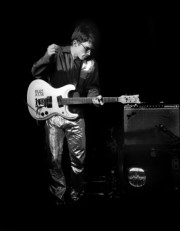Guitar Quest: Mosrite "Copy"
by Paul Chesney
In 2001 after discovering the amazing sound of what immediately became my favorite band of all time "Man or Astroman?", I set out to find a way to use thier music for a Super 8mm feature film, "Project 9: Chroniacals of a Girl Genius". It was then that I discovered the high cost of purchasing not only the rights to legally use a song, but the recording of a song.
Through an e-mail, I contacted a gentleman at Touch N Go records just to get some advice on what to do, hoping to get permission to use the songs. He informed me that (at the time) the band had just broken up and would be almost impossible to reach, though he'd try to get my message thru to them in an email. It was a nice gesture, but obviously a dead end.
Then, one evening at a memorable Halloween party, I spilled my woes over drinks in the tiki basement bar of the Amino Acids guitarist who, along with the soon to be bass player, spoke words I never forgot, words that launched me into a ten year search for a specific guitar sound- You can play that kind've music yourself, yeah you can do that. Find out what kind've equipment they use to play & record with and get your own, buy it used, it's not that hard.
This distant glimmer of hope lead to many years to come of internet research and subsequent purhases. But after trying new pedals, mics, and even a pricy Fender twin Reverb amp, I eventually found that the true high treble gurgling reverb astro-crunch I had been looking for was mainly an aspect of the unique single-coil bridge pickup sound in a 1965 Mosrite Mark 1, an expensive collectors guitar once played exclusively by the Ventures.
With it's $4,000-$6,000 pricetag being way out of my budget, I decided to sell my inexpensive DeArmond "bluesbird" re-issue (which I mistakenly took for a rockabilly style guitar back in 98 before I even knew the difference between humbuckers and single-coil) for a mere $400 and began the quest to purchase an inexpensive Mosrite copy, of which there were several to choose from.
It seemed like fate. First, I was continuously outbid on Ebay in the last 5 seconds on several Univox Hi-flyers, which remain in high-demand simply because of celebrity association with the likes of kurt cobain and some guitarist from the Ramones. Then someone pointed out Eastwood guitars, and the sidejack DLX Mosrite copy in my pricerange of $400-$600. But then I noticed, they had no zero fret, a wide neck and a Fender style 'wammy bar' tremolo instead of the spring type found in a Mosrite. Not wanting to take a chance on a guitar I couldn't try before I buy, I kept searching.
Finally, Carla came accross a strange looking 1969 Silvertone 14459L from an Ebay seller in Pensylvania and it looked like an actual Mosrite Mark 1, minus the pick guard design. It had a zero fret, thin neck, German-carve edges, single spring tremolo and 25" scale length. Wasn't long before I decided to take the chance as by this time I had learned the importance of using a zero fret to accomplish the low action that is so crucial to the Mosrite sound.
The Teisco made Silvertone 1445 served me well, and I gladly used it on the first 10 tracks of Beady Dine. There was one thing though, the pickups being extremely weak I had to position them directly below the strings to sound good (not very 'hot'). In time, I experimented with replacing the bridge pickup (since that's the only one I use). Of those, M3 of California's RH-100 certainly was the best. But still, there was this persistent lingering doubt in my mind. I never even had a chance to TRY a Mosrite. What if....just what IF Mosrite made all the difference in the world.
So, when Carla & I went to California where she was sent on assignment to photograph the L.A. Auto Show, I convinced her to take the drive to Bakersfield where we visited the legendary Front Porch Music, one of the only places in the world proported to allegedly sell Mosrites. The mission: try one for the first time ever and put an end to the Mosrite mystery once and for all.
After being greeted by a bunch of friendly guys who worked there and actually hanging out for a while, I then asked to play a Mosrite at which time they got a 1/4" cable and an amp hookup and let me go to town.
Shortly after, I mentioned wanting to buy a Mosrite bridge pickup and they made a quick phonecall "next door" where apparantly Dana Mosely was busy making them by hand. A few minutes later, she came through the door carrying my brand new hand-made Mark 1 bridge pickup. I am to this day at a complete loss of words for what that was like. There is no single experience in this lifetime to match the pleasant friendly encounter Carla & I had with Dana, who was willing to hang out for several minutes and chat. I was completely blown away.
Paul's Guitar Sound
Pedals/Amps
- Digitech RP50- custom settings with Fender Twin amp modeler
- 1970's Fender Twin Reverb amp
- Modtone Vintage Analog Delay
- Dan Electro Danecho










